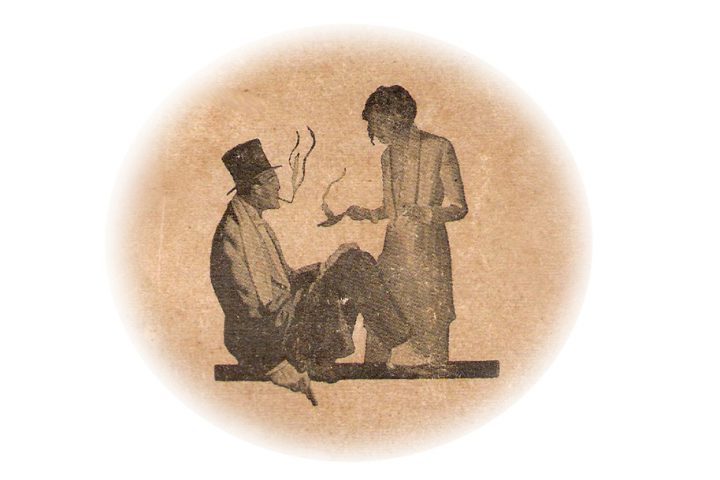Around Town . . . .
Pitzer College Bulletin, 1983-84
Edited by Ronald K.S. Macaulay, et al
131 pp.
Concern of late has turned to the “crisis” of liberal education. The crisis, simply stated, is that fewer college students are enrolling in liberal arts curricula; students are, instead, stampeding to “practical” disciplines such as business, law, and engineering. Many universities are reinstating basic course requirements in “Western Civilization” (which often include a requirement of a course in one “non-Western” culture), but that has not stemmed the rising tide of disrespect for the liberal arts.
It is not that the liberal arts have become “unmarketable” – the liberal arts have always been “impractical” in the naked economic sense, but nevertheless considered essential if one desired to be thought of as an educated man. The crux of the problem is that the liberal arts, to use a phrase popular with leftist academics in the 1960s, are no longer “relevant” to the purpose of becoming “educated.”
Liberal education has lost its purpose and has lapsed into a decadence that is increasingly obvious to serious students. The university, as its very name implies, used to set itself a broad mission, by way of ultimate questions: Why do we live the way we do? Can we live better? What are our obligations to others? to ourselves? to God?
It used to be presumed that the partial answers accumulated by the “Western tradition” still retained their urgency for succeeding generations, but this is no longer so. These questions are no longer seriously posed by liberal education because liberal education no longer supposes there is truth to be sought. Instead, according to the modern method, the survey of “cultures” has replaced the quest for truth, because “truth” is seen as being relative to “cultures.” Thus the study of cultures, including our own, is merely a survey of idiosyncratic and arbitrary answers to ultimately meaningless questions.
A dramatic example of this malignancy is found in the pages of last year’s Pitzer College Bulletin. Dean Macaulay’s introduction is most revealing:
“Progress is the mother of problems” observed Chesterton and progress has certainly created problems for educational institutions. One problem is that scholarly activity is constantly adding to our store of knowledge. Voltaire complained that the multitude of books was making us ignorant, and the number of books has increased greatly since his time. Every year there is literally more to learn, more to read, more to examine critically, more to remember, more to be ignorant about. Another problem is that new developments may make old techniques obsolete for practical purposes . . . a third problem is that new developments are not always the advance that they may appear to be at first sight.
Were Macaulay writing about the mission of a technical college, this might make sense, but for a liberal arts college this is quite odd; he seems to equate liberal learning with the mere accumulation and management of raw knowledge-knowledge here being understood not as a manner or method of discernment, but simply as data. But the sentences that follow are truly astonishing:
In such circumstances, it has become increasingly difficult to determine what a liberal arts education ought to provide. What is clear is that it can no longer be seen as providing that core of knowledge which all educated people possess.
This statement is breathtaking in its implications. Does this really mean to say that what was once considered the core of the liberal arts-the classics, Shakespeare, science, philosophy-can no longer be thought so because it has been superseded by constant discovery of new “knowledge” by modern science, or the discovery of quaint practices by anthropologists? That what was once the lodestar of our learned civilization can no longer be considered our common heritage? “The university,” political philosophy professor Allan Bloom noted in savage indictment of “Our Listless Universities,” “has no vision, no view of what a human being must know in order to be considered educated.” In its 1983-84 Bulletin, Pitzer College plaintively confesses as much.
Curiously, the new Pitzer College Catalogue, 1984-85 contains a new Introduction, dramatically different from the 1983-84 Bulletin’s Introduction: “Pitzer College offers a traditional liberal arts education, with a difference,” it begins. This new shorter Introduction is innocuous in itself, but the rest of the new Catalogue is unchanged from the old Bulletin, suggesting that Pitzer’s “traditional liberal arts education” is still informed by the vacuous spirit of the Bulletin’s Introduction. Throughout the new Catalogue one finds frequent examples of the condescending approach that views truth as a relative function of “culture.” Consider one of the freshman seminars, “The Individual in Culture” This course, the Catalogue tells us, “surveys the nature and limits of human plasticity, the variability and uniformity of personality within and between cultures, and the social context of conformity and deviance.” Is it any wonder that, faced with this sort of academic masturbation, sensible students would rather study sedimentary petrology or income tax accounting? Is it any wonder that those students who do persevere in “liberal studies” seem so spineless about it, lacking any passionate attachment to their “culture”?
“Certainly the tradition of liberal education is defunct,” founding editor George Forsyth noted in the inaugural issue of this Review three years ago. “Modern education understands itself to be a catalogue of delights and a warehouse of instruments. It promises to reveal to its students the means necessary for the realization of any object, without discrimination or judgment between objects.” This is true of the approach to liberal education at Pitzer because, by its own admission, the college cannot “determine what a liberal arts education ought to provide.” But without some guiding principle, some architectonic purpose, how is one to judge whether one has succeeded-or failed-in being liberally educated? How can one measure progress in that learning? Or, to put it in terms clear to that practical-minded, non-liberal arts student; how does a Pitzer graduate know he got his money’s worth?

